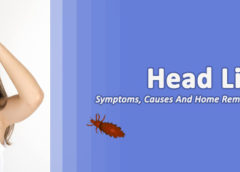Head lice are tiny insects which the human scalp feeds on blood. A head lice infestation most commonly affects children and is typically the result of a direct transfer of lice from one person’s hair to another’s hair.
The infestation of the head-lice is not a symptom of bad personal hygiene or an unclean living climate. Head lice do not carry infectious bacterial or viral diseases.
Head lice can be treated with over-the-counter and prescription medicines. Follow treatment directions carefully to get rid of lice and their eggs from your scalp and hair.
Also used to treat head-lice infestations are many home or natural remedies, but there is little or no clinical evidence of their effectiveness.
Symptoms
Itching is the most common symptom of an infestation.
This is due to an allergic reaction to louse saliva. Some people are very prone to louse bites and have serious itching. Others are not allergic to the saliva, or they build up a tolerance and have little or no itching, even with repeated infestations. Some people do not experience itching for the first 2 to 6 weeks of an infestation, as it can take this long to become sensitized.
Some people with lice never realize they’re infested. However, there are several telltale signs that the bugs are present on the scalp. These include
- Sores on the head from scratching
- Swollen lymph nodes, or glands
- Pink eye
- A ticklish feeling on the scalp or neck.
- An itchy scalp (the result of an allergic reaction to the bug’s saliva).
- The presence of nits (lice eggs) on shafts of hair.
- Difficulty sleeping, which can lead to irritability.
- Tiny red bumps on the neck and shoulders of the scalp
- Lice appearance on the scalp;
Causes
In urban daycare centres and primary schools, the head lice are usually spread among children crowded together. They have no wings, so they cannot leap or float from person to person; they travel easily by crawling or grabbing a shaft of hair with tiny front grips and then swing from one strand of hair to another. In this way, as children play close together with their heads or indirectly by caps, coat hooks, scarves, bike helmets, headphones, hairbrushes, toys, or bedding, they communicate by direct head to head touch. Poor hygiene in head lice, though it does in body lice, does not play a part.
Risk Factors
Children in nursery and primary school have the highest chance of developing head lice. They tend to play closely together. There’s also an increased risk of head lice for family members of school-aged children. People who work in a daycare centre, preschool, or elementary school share this risk.
Home Remedies for Head Lice
Some steps can be taken to cure a head lice infestation before taking any prescription medicine.
Wet-Combing
Combing wet hair with a fine nit comb will remove lice and some nits. Research is inconclusive on the effectiveness of this method. When well as the hair being wet, something like a hair conditioner can be used to lubricate the hair.
At least twice during a session, comb the entire head from the scalp to the end of the neck. The procedure will be repeated every 3 to 4 days for at least 2 weeks until no further lice are found.
Essential oils
Clinical studies suggest that certain natural vegetable oils may have a toxic effect on lice and eggs. These products include:
- Tea tree oil
- Anise oil
- Ylang-ylang oil
- Nerolidol, a chemical compound found in many plant oils
- Eucalyptus oil
- Lavender oil
A spray containing a combination of coconut and anise was found to be significantly more effective in clearing head lice than permethrin lotion in one study.
One benefit of coconut oil and anise is that the effects are not neurological but physical, so it is highly unlikely that the lice will develop resistance. The drug dries away the lice’s waxy outer layer, causing lethal dehydration.
Prevention
It is difficult to prevent the spread of head lice in childcare facilities and schools among children because there is so much close contact.
There is a small risk of indirect transmission from personal objects. You should also warn your child to stop a head-lice infestation:
- Hang garments on a separate hook from other children’s garments.
- Avoid sharing combs, brushes, hats and scarves.
- Not lie on beds, couches or pillows that have been in contact with a person infected by head lice.
- Hang the garments from other children’s garments on a different hook
- Do not lie on beds, sofa beds or pillows in contact with a person infested with head lice.
A concern about head-lice transmission is not seen as a good reason to avoid sharing sports and bicycling protective headgear when sharing is required.

Leave a Reply
You must be logged in to post a comment.